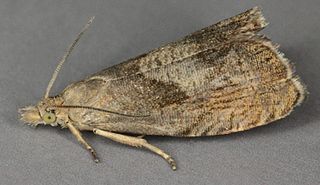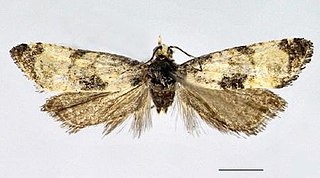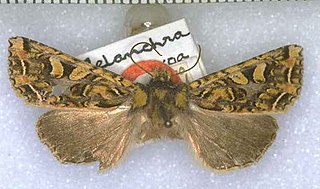| Eucosma cana | |
|---|---|
 | |
| Eucosma cana. Dorsal view | |
| Scientific classification | |
| Kingdom: | |
| Phylum: | |
| Class: | |
| Order: | |
| Family: | |
| Genus: | |
| Species: | E. cana |
| Binomial name | |
| Eucosma cana | |
| Synonyms | |
| |
Eucosma cana, the hoary bell, is a species of moth of the family Tortricidae.
| Eucosma cana | |
|---|---|
 | |
| Eucosma cana. Dorsal view | |
| Scientific classification | |
| Kingdom: | |
| Phylum: | |
| Class: | |
| Order: | |
| Family: | |
| Genus: | |
| Species: | E. cana |
| Binomial name | |
| Eucosma cana | |
| Synonyms | |
| |
Eucosma cana, the hoary bell, is a species of moth of the family Tortricidae.
This quite common and widespread species can be found in most of Europe, in China (Zhejiang, Fujian, Henan, Guangdong, Yunnan, Shaanxi, Gansu, Xinjiang), in Japan, in Central Asia, in Russia, and in Kazakhstan. [2] [3] These moths mainly inhabit flower meadows, rough grounds and waysides.
Eucosma cana can reach a body length of about 11.5 mm (0.45 in) and a wingspan of 16–23 mm. [4] The head of these moths is reddish brown, while the thorax is light brownish on the sides, dark brownish in the middle. The ground colour of the forewings is light brown or greyish, with light longitudinal discal streaks. The edges are feathered. The hindwings are dark gray toward the margins. This species in rather similar to Eucosma hohenwartiana , [4] which has a darker ground colour of the forewings, lacking the longitudinal lighter streaks. Meyrick describes it -The forewings are elongate, fold reaching to near middle ; ochreous, somewhat blackish -sprinkled, with several suffused ochreous whitish longitudinal streaks confluent in middle towards base, ceasing before very narrow central fascia of ground-colour ; an oblique wedge-shaped ferruginous suffusion from dorsum near base ; posterior half of costa with very oblique whitish strigulae, abruptly ceasing at 1/3 ; ocellus metallic-edged, containing one or two incomplete black dashes ; termen sinuate. Hindwings in male pale grey, darker terminally, in female darker.The larva is dull pink ; head and plate of 2 brown. [5]
Adults are on wing in a single generation from June to August. [4] The larvae are 10–11 mm long, pale orange or dark ocher, broad and somewhat flat. They feed on the flowerheads of Cirsium , Carduus species and of Centaurea nigra (black knapweed) [2] [4] and can be found from August to May.

Dichrorampha simpliciana is a moth of the family Tortricidae. It is found in Europe and the Near East.

Epinotia solandriana is a moth of the family Tortricidae. It is found in Europe, China, Korea, Japan, and Russia.

Phalonidia manniana is a moth of the family Tortricidae. It is found in most of Europe.

Amblyptilia epotis is a moth of the family Pterophoridae. It is endemic to New Zealand and is found in the South and Stewart Islands. It inhabits mountainous terrain covered in alpine vegetation or alternatively alpine wetland habitat. The adults of this species are on the wing from February to March. In appearance the adults of this species are variable in colour however this species can be distinguished from similar species by the oblique apical streak on its forewings as well as the patch of white on the costa cilia towards the apex of the forewing.

Dichrorampha alpinana, the broad-blotch drill, is a species of moth of the family Tortricidae. It is found in almost all of Europe.

Cochylis dubitana, the little conch, is a moth of the family Tortricidae. It is found in China (Heilongjiang) and most of Europe. and the Caucasus. It is also found in North America, where it has been recorded from Colorado, Maine, Ontario and Washington.
Ptocheuusa paupella, the light fleabane neb, is a moth of the family Gelechiidae. It is found from central and southern Europe to the Ural Mountains. It is also found in Turkey and India.

Cochylis pallidana, the sheep's-bit conch, is a moth of the family Tortricidae. It was described by Zeller in 1847.

Physetica prionistis is a moth of the family Noctuidae. It was described by Edward Meyrick in 1887. It is endemic to New Zealand and is widespread throughout the North, South and Chatham Islands. This species can be found in open clearings of shrubland and forest at altitudes from sea level up to the alpine zone. Adults are on the wing throughout the year and are attracted to sugar traps and occasionally to light. The life history of this species is unknown as are the larval host species.

Ichneutica scutata is a moth of the family Noctuidae. It is endemic to New Zealand. This species can be found in the southern parts of the North Island as well as the eastern parts of the South Island. It is similar in appearance to I. insignis and I. skelloni but can be distinguished as I. scutata is much paler in appearance. It is likely this species inhabits lowland tussock grasslands as well as coastal dunes although it is not common in inland tussock grasslands. The larvae feed on a variety of herbaceous plants such as Plantago and Convolvulus species, Plagianthus divaricatus. It pupates on soil near its host plants. The adults are on the wing from late March to July.

Meterana tetrachroa is a species of moth of the family Noctuidae. This species is endemic to New Zealand. It is classified as "Data Deficient" by the Department of Conservation.
Terthreutis kevini is a species of moth of the family Tortricidae. It is found in Thailand.

Eucosma aspidiscana, the golden-rod bell, is a species of moth of the family Tortricidae. It is found in China, Mongolia, Korea, Japan, Russia, North Africa and most of Europe. The habitat consists of woodlands, downland, waste grounds and cliffs.

Pyrgotis eudorana is a species of moth of the family Tortricidae. It is endemic in New Zealand and has been observed in both the North and South Islands. However it is regarded as a rare insect. This species inhabits native forest. Larvae exclusively feed on Muehlenbeckia australis and adults are on the wing from November to April. Adults are attracted to light.
Bassarodes is a monotypic moth genus in the family Xyloryctidae. Its only species, Bassarodes siriaca, is found on the Solomon Islands. Both the genus and species were first described by Edward Meyrick in 1910.

Ichneutica paraxysta is a moth of the family Noctuidae. It is endemic to New Zealand. This species is very similar in appearance to its close relative I. acontistis but as the range of the two species do not overlap this is unlikely to cause confusion. I. paraxysta is only found in the North Island at the subalpine zones in the Mount Taranaki region and at Mount Ruapehu. It prefers tussock grassland and shrubland habitat. The life history of this species is unknown as are the host species of its larvae however it has been hypothesised that the larval host plants are species in the genera of Poa and Festuca.

Ichneutica epiastra is a moth of the family Noctuidae. It is endemic to New Zealand and is found throughout the North, South and Stewart Islands. This species prefers open habitats such as wetlands, dunes and forest clearings. Eggs are laid in the summer or autumn and larvae feed during winter and spring. The larval host species are found within the genus Austroderia. The adult moths are on the wing between October to February. Adult I. epiastra can possibly be confused with the similar species I. arotis and I. haedifrontella however there are differences in appearance that enables I. epiastra to be distinguished from these two species. In particular I. epiastra has long sharp-tipped ‘horns' on its head that are diagnostic. The adults of this species appear reluctant to be attracted to light although they do come more frequently to the brighter mercury vapour traps.

Epinotia abbreviana is a moth of the family Tortricidae. It is found in Europe and was first described by Johan Christian Fabricius in 1794.

Ichneutica ceraunias is a moth of the family Noctuidae. It is endemic to New Zealand. This species is found from the central North Island to the bottom of the South Island. Hosts of the larvae are species of Chionochloa and Festuca. This colourful moth is variable in appearance and can be mistaken for Ichneutica dione. Adults are on the wing from October to February.

Tingena ancogramma is a species of moth in the family Oecophoridae. It is endemic to New Zealand and has been found in the Hen and Chicken Islands, the North Island and the South Island. Adults are on the wing in summer and autumn and inhabit open areas of forest scrubland.